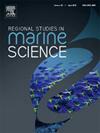A spatio-temporal assessment of seawater quality in Miri-Sibuti Coral Reef: Evaluating for metal pollution, sources and dynamics
IF 2.1
4区 环境科学与生态学
Q3 ECOLOGY
引用次数: 0
Abstract
Coral environments are sensitive to seawater quality, and their sustenance depends on understanding the dynamics of geochemical variables, especially in trace levels. Miri-Sibuti Coral Reef National Park (MSCRNP) is a unique marine reserve in the state of Sarawak, NW Borneo, Malaysia, which attracts tourists worldwide. In this study, seawater samples were collected from MSCRNP in three different diving sites (Eve’s Garden (EG), Anemone Garden (AG) and North Siwa (NS)) at different depths for three seasons (pre-southwest monsoon (PRSWM), post-southwest monsoon (POSWM) and northeast monsoon (NEM). Insitu parameters (temperature, pH, salinity and turbidity) were measured in the field. The concentration of trace metals was determined in the water column (sea surface layer, middle layer and bottom water) using standard procedure. Statistics and pollution indices were used to identify the possible sources of metals and the pollution status of the seawater. From the analytical results, the vertical distribution of trace metal concentrations with respect to the locations and seasons was identified. pH ranging from 7.8 to 8.4 with a depth-wise increasing trend in NS during NEM. Similarly, a decreasing trend of turbidity was observed in AG and EG in all the seasons with respect to depth. A higher concentration of trace metals was observed during NEM, particularly at EG and NS. Fe, Ni and Pb are the dominant metals in all the seasons. Fe concentration varies from 789 to 1478 µg/L, averaging 1112 µg/L irrespective of seasons and locations. The suspended solids/sediments discharged by the river runoff were the main contributor to the distribution of metals. The release of metals from the suspended particles through desorption at the surface layers and the exchange of metals between water-sediment interface at the bottom water were observed. In addition, coastal development and other anthropogenic activities in this region were also contributed to the metal pollution.
米里-锡布提珊瑚礁海水质量时空评估:评估金属污染、来源和动态
珊瑚环境对海水质量非常敏感,它们的生存有赖于对地球化学变量(尤其是痕量水平)动态的了解。米里-西布提珊瑚礁国家公园(MSCRNP)是马来西亚婆罗洲西北部沙捞越州的一个独特的海洋保护区,吸引着世界各地的游客。本研究在三个季节(西南季风前(PRSWM)、西南季风后(POSWM)和东北季风(NEM))从 MSCRNP 三个不同潜水点(夏娃花园(EG)、海葵花园(AG)和北锡瓦(NS))的不同深度采集海水样本。实地测量了现场参数(温度、pH 值、盐度和浊度)。采用标准程序测定了水体(表层、中层和底层)中的痕量金属浓度。统计和污染指数用于确定金属的可能来源和海水的污染状况。根据分析结果,确定了痕量金属浓度在不同地点和不同季节的垂直分布情况。同样,在 AG 和 EG,所有季节的浊度都呈深度递减趋势。在 NEM 期间,痕量金属的浓度较高,尤其是在 EG 和 NS。铁、镍和铅是所有季节的主要金属。铁的浓度从 789 微克/升到 1478 微克/升不等,平均为 1112 微克/升,与季节和地点无关。河流径流排出的悬浮固体/沉积物是造成金属分布的主要因素。悬浮颗粒中的金属在表层通过解吸作用释放出来,在底层水与沉积物界面之间进行金属交换。此外,该地区的沿海开发和其他人为活动也造成了金属污染。
本文章由计算机程序翻译,如有差异,请以英文原文为准。
求助全文
约1分钟内获得全文
求助全文
来源期刊

Regional Studies in Marine Science
Agricultural and Biological Sciences-Ecology, Evolution, Behavior and Systematics
CiteScore
3.90
自引率
4.80%
发文量
336
审稿时长
69 days
期刊介绍:
REGIONAL STUDIES IN MARINE SCIENCE will publish scientifically sound papers on regional aspects of maritime and marine resources in estuaries, coastal zones, continental shelf, the seas and oceans.
 求助内容:
求助内容: 应助结果提醒方式:
应助结果提醒方式:


